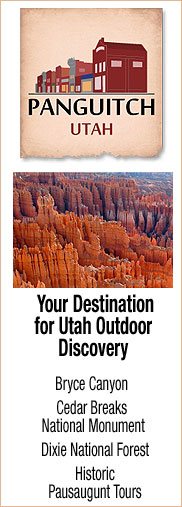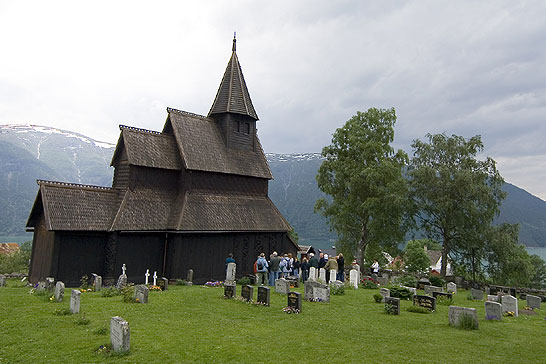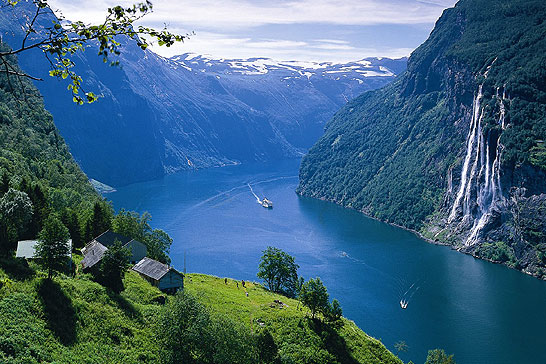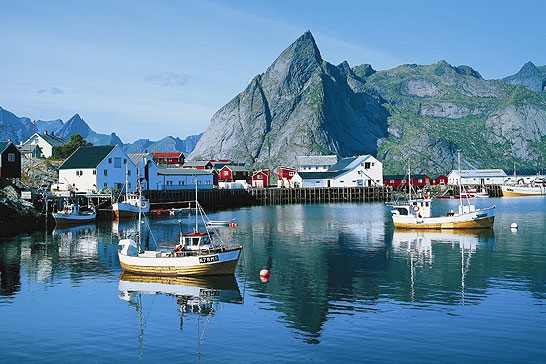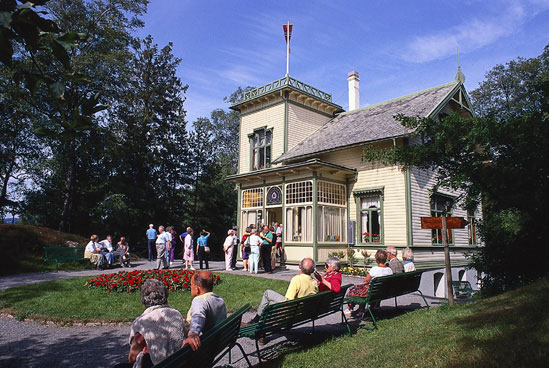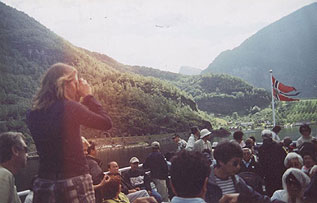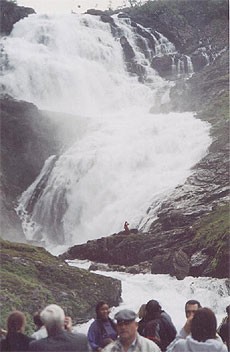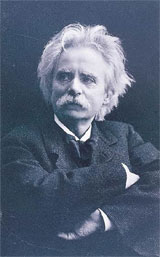 |

|
|
 |

|
Norway's Fjords |
|
With its jagged mountain peaks that jolt vertically from the sea, stunning waterways, cascading waterfalls, tiny fishing villages and mountain farmhouses, the fjords of Norway would be my pick for the most beautiful place on the planet. I'm not exactly going out on a limb when I say this. Two of Norway's most famous fjords, the Geirangerfjord and Nærøyfjord, have joined the Great Wall of China, the pyramids of Egypt, and the Grand Canyon as a UNESCO World Heritage Site-a prestigious award whose purpose is to preserve the cultural and natural importance of a site for future generations. And National Geographic Traveler Magazine also rated Norway's fjords as the top travel destination in the world in their first "Index of Destination Stewardship" - an elite list of the least spoiled, great places on earth. To understand the fjords is to understand the Norwegian character, whose national identity has been formed by its passionate bond with nature. When a Norwegian goes on vacation-an average of six-weeks a year-the destination of choice is (usually) the Norwegian countryside. CARVED BY THE HANDS OF GOD
The Geirangerfjord and her
Seven Sisters is an UNESCO World Heritage Site.
Credit: Courtesy Hurtigruten Nestled on the western coast of Norway, the fjords were carved out in a succession of ice ages. When glaciers retreated approximately 12,000 years ago, plants soon appeared, animals thrived and man eventually made his way into this spectacular, but remote, heaven on earth. Small fishing villages were established and tiny sod roofed farmhouses quietly dotted the landscape, some situated on mountains so steep that they required a ladder to ascend the terrain. Once tax collectors realized there were people living in this isolated region, they made an annual trek to the farms, only to find that many of the ladders had mysteriously disappeared. When the first tourists arrived-primarily European aristocracy-who came to fish in this untouched paradise of crystal-clear waters, they were guaranteed all the fish they could carry. Word spread, and the fjords became the sportsperson's paradise. Soon the rest of the world heard about them. HURTIGRUTEN: "The World's Most Beautiful Voyage."
Lofoten fishing village, along the fjords.
Credit: Courtesy Hurtigruten
In 1891 Norwegian Coastal Voyage (now Hurtigruten) established a daily, year-round boat service along the western coast of Norway, with Bergen at the southern terminus and the Russian border at the north. With 34 ports of call, the coastal trek became a lifeline along the west coast of Norway, carrying cargo to isolated villages and farming communities. Tourism quickly became an important component of the voyages, giving people the opportunity to experience the fjord-filled coastline, Midnight Sun and the Northern Lights. Travelers came in the thousands, making Norwegian Coastal Voyage one of Europe's biggest attractions. On my four-day journey, I found that more than 60 percent of the tourists on the voyage were Norwegian. It was wonderful to travel with locals and see the county through their eyes-and the fact that it was a real working cargo vessel made the experience even more authentic. The vessel makes an interesting hybrid of a working ship and tour boat, with all the comforts of spacious cabins, lounges and dining rooms. Sitting on the deck at midnight, sipping a glass of aquavit-the national drink of Norway-while the sun refused to go down was an amazing experience. The journey also includes land tours by bus; which meet back with the vessel at future ports. Bergen - Gateway to the Fjords Your journey will begin in Hanseatic Bergen, but before you hop on-board the boat, it is essential that you spend at least two days in this World Heritage City. Bergen boasts endless tourist attractions, and the Bergen Tourist Card is an important component to your tour of this historic harbor town. The price allows you free or reduced- price admittance to the Bergen Art Museum, Fantoft Stave Church (a medieval wooden cathedral), harbor boat tour, Bergen Castle, St Mary's Church, and Troldhaugen, composer Edvard Grieg's home. If you're lucky, you might catch a concert in Troldhaugen's intimate concert hall, discreetly built into the landscape and overlooking Grieg's working studio, where he wrote most of his later work. Wander through the harbor fish market and down the wooden streets of the historic warehouse district. A fish buffet should be on everyone's list for a sampling of Bergen's world-famous fish soup, gravlaks (cured Atlantic salmon), fish cakes and hearty breads, all washed down with the city's own Hansa beer. The local watering hole, Café Opera makes for a great late night stop. http://www.visitbergen.com DESTINATIONS ON
YOUR VOYAGE
Trondheim - City of the Viking King
Caption: Troldhaugen, the Edvard
Grieg Museum, is located on
Lake Nordås in Bergen, Norway. Credit: Courtesy Hurtigruten Trondheim is the third largest city in Norway, and was the country's first capital for two hundred years. Two millenniums ago, Viking King Olav Tryggvason sailed up the Trondheim fjord in his longship and established this city. Trondheim's most important tourist attraction is St. Olav Catholic Church, built on the site of his grave. Numerous kings of the middle ages have found their final resting place in Trondheim, and the city has gained popularity as one of Europe's most important medieval pilgrimage centers. With time permitting make a stop at the Trøndelag Folk
Museum - an open air museum dating back to 1909. The museum showcases
the various building traditions through time, with 60 vintage
buildings on display, ranging from wooden huts to city mansions.
LOFOTEN ISLANDS - Lutefisk Tromsø - Paris of the Arctic Tromsø is the largest city in the Nordic countries north
of the Arctic Circle and is home to the world's most northern
university and cathedral, brewery, botanical garden and planetarium
Less than a century ago, visitors were surprised to find culture
and intellectual activity in a city so far to the north. Of all
the destinations on my journey I found the residents of this city
of 53,622 to be the most open and friendly in all of Norway. Look
closely and you will see location used in the original film, Insomnia
(1997). The Sami - Scandinavia's Aborigines Hurtigruten.us * VisitNorway.com/us HOW TO GET THEREScandinavian Airlines |
|
Hi Ed, I was just reading your great story about traveling through the Norwegian countryside and the voyage along the coast – sounds amazing. Iíve been to Oslo, but definitely would like to return to Norway one day to explore exactly what you wrote about. Cheers, Ed, The photos are spectacular. I can envision many a romantic novel
inspired by these majestic sceneries. Makes me want to do a little
more research on Norway. John Lenon must have been one of the
converts when he wrote "Norwegian Woods." Peter, Thanks for the kind words and taking the time to write. Indeed,
Norway was paradise on earth, and I dream of returning again and
again. You had a funny line about John Lennon being so inspired
by the beauty of Norway that he composed the song, "Norwegian
Wood." If I'm not mistaken, his reference to "Norwegian
Wood" is just that: an inexpensive pine wood from Norway
that was becoming popular in the UK. I did read somewhere, though,
that "I Want to Hold Your Hand" was inspired by Norwegian
fjord trek. Ed, Reading Peter's implication that "Norwegian
Wood" was based on a trip that John Lennon took to Norway
led me to do some research. Of course, just cause it's on the 'net doesn't mean it's true.
 |
© TravelingBoy.com 2015. All Rights Reserved.
This site is designed and maintained by WYNK Marketing. Send all technical issues to: support@wynkmarketing.com
|
Edvard Grieg - Troldhaugen,
Bergen, Norway -
Grieg and his wife built
a home on Lake Nordås on the edge of Bergen, which he called
his best opus so far. Christened, Troldhaugen, the Victorian villa
featured a tower, flag pole and rooftop vegetable garden. It soon
became a center piece for Bergen's artistic community and visiting
dignitaries. Greig loved the attention, but needed quiet to work,
and built a composer's hut by the lake. Grieg died in 1907 of
chronic exhaustion. But today his legacy lives on at Troldhaugen
- a living museum consisting of the Edvard Grieg Museum, the Villa,
the Composer's Hut, Concert Hall and Edvard Grieg´s tomb.
The highpoint of a visit to Troldhaugen is a recital at the concert
hall, which is discreetly built right into the grounds, complete
with sod roof. The floor-to-ceiling windows behind the stage,
overlooks the composer's hut, where Grieg would work, superstitiously
sitting on a stack of sheet music by Beethoven so that he could
reach the piano. At the end of each day, he would leave a note:
"If anyone should break in here, please leave the musical
scores, since they have no value to anyone except Edvard Grieg."
Last November marked the 100th year anniversary of his death.
|




